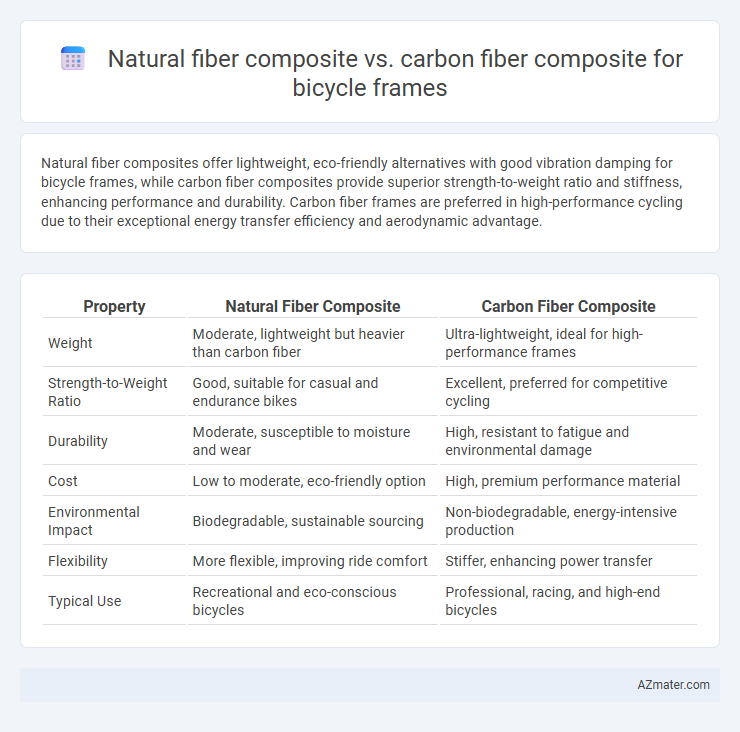Natural fiber composites offer lightweight, eco-friendly alternatives with good vibration damping for bicycle frames, while carbon fiber composites provide superior strength-to-weight ratio and stiffness, enhancing performance and durability. Carbon fiber frames are preferred in high-performance cycling due to their exceptional energy transfer efficiency and aerodynamic advantage.
Table of Comparison
| Property | Natural Fiber Composite | Carbon Fiber Composite |
|---|---|---|
| Weight | Moderate, lightweight but heavier than carbon fiber | Ultra-lightweight, ideal for high-performance frames |
| Strength-to-Weight Ratio | Good, suitable for casual and endurance bikes | Excellent, preferred for competitive cycling |
| Durability | Moderate, susceptible to moisture and wear | High, resistant to fatigue and environmental damage |
| Cost | Low to moderate, eco-friendly option | High, premium performance material |
| Environmental Impact | Biodegradable, sustainable sourcing | Non-biodegradable, energy-intensive production |
| Flexibility | More flexible, improving ride comfort | Stiffer, enhancing power transfer |
| Typical Use | Recreational and eco-conscious bicycles | Professional, racing, and high-end bicycles |
Introduction to Bicycle Frame Materials
Natural fiber composites offer lightweight and sustainable alternatives for bicycle frames, featuring fibers like hemp, flax, or jute embedded in bio-based resins. Carbon fiber composites provide superior strength-to-weight ratios, stiffness, and durability, making them ideal for high-performance cycling applications. The choice between natural fiber and carbon fiber composites depends on factors such as environmental impact, mechanical properties, cost, and intended use of the bicycle.
Overview of Natural Fiber Composites
Natural fiber composites used in bicycle frames are made from renewable resources such as flax, hemp, jute, and sisal, offering eco-friendly alternatives to synthetic fibers. These composites exhibit lower density and can provide adequate strength and vibration damping, improving ride comfort. Although natural fibers generally deliver lower stiffness and durability compared to carbon fiber composites, advancements in fiber treatment and resin systems help enhance their mechanical performance for sustainable cycling applications.
Carbon Fiber Composite: Key Properties
Carbon fiber composites exhibit exceptional strength-to-weight ratios, making them ideal for high-performance bicycle frames that require stiffness and durability without added weight. Their high tensile strength and excellent fatigue resistance provide enhanced ride quality and long-term reliability. Carbon fiber's ability to be precisely molded into aerodynamic shapes further optimizes bike frame performance compared to natural fiber composites.
Strength and Stiffness Comparison
Natural fiber composites exhibit lower tensile strength and stiffness compared to carbon fiber composites, influencing performance in bicycle frame construction. Carbon fiber composites offer superior specific strength, with tensile strengths often exceeding 3,500 MPa and moduli above 230 GPa, enabling lightweight frames with exceptional rigidity. Natural fibers, such as flax or hemp, typically provide tensile strengths around 500-900 MPa and moduli of 30-70 GPa, resulting in frames with reduced stiffness and strength but improved environmental sustainability.
Weight and Performance Analysis
Natural fiber composites offer a lightweight alternative to traditional materials, with densities typically ranging from 1.2 to 1.5 g/cm3, resulting in moderately heavier bicycle frames compared to carbon fiber composites, which have densities around 1.6 g/cm3 but superior specific strength and stiffness. Carbon fiber composites excel in performance due to their high tensile strength (up to 7000 MPa) and excellent fatigue resistance, enabling faster acceleration and improved handling in competitive cycling scenarios. Weight savings with carbon fiber frames generally range from 0.5 to 1.5 kilograms compared to natural fiber composites, making carbon fiber the preferred choice for performance-focused bicycle frames.
Environmental Impact and Sustainability
Natural fiber composites for bicycle frames offer significant environmental benefits due to their biodegradability, lower carbon footprint, and use of renewable resources like flax, hemp, or jute fibers. Carbon fiber composites, while providing superior strength-to-weight ratios, rely heavily on energy-intensive manufacturing processes and non-renewable petroleum-based resins, resulting in higher greenhouse gas emissions and limited recyclability. Choosing natural fiber composites supports sustainability through reduced environmental impact, enhanced end-of-life eco-friendliness, and alignment with circular economy principles in bicycle manufacturing.
Vibration Damping and Ride Comfort
Natural fiber composites, such as flax or hemp, offer superior vibration damping due to their inherent flexibility and ability to absorb road shocks, resulting in enhanced ride comfort for bicycle frames. Carbon fiber composites, while exceptionally stiff and lightweight, tend to transmit more road vibrations, which may compromise comfort despite their performance benefits. The choice between these materials affects the balance between ride smoothness and structural efficiency, making natural fibers favorable for comfort-oriented cycling and carbon fiber ideal for high-performance applications.
Manufacturing Processes and Cost
Natural fiber composites for bicycle frames typically use processes like resin infusion or compression molding, which are less energy-intensive and require simpler equipment compared to the autoclave curing required for carbon fiber composites. Carbon fiber composite manufacturing involves high-cost raw materials and specialized labor, leading to higher overall production expenses. Natural fiber composites offer cost advantages and faster production times but generally result in lower strength-to-weight ratios compared to carbon fiber frames.
Durability and Long-Term Maintenance
Natural fiber composites in bicycle frames offer moderate durability with resistance to minor impacts and corrosion but tend to degrade faster under prolonged moisture exposure compared to carbon fiber composites. Carbon fiber composites provide superior strength-to-weight ratios, exceptional fatigue resistance, and minimal maintenance requirements, making them ideal for long-term usage in demanding conditions. Despite higher upfront costs, carbon fiber frames typically require less frequent repairs and maintain performance integrity better over time than natural fiber alternatives.
Choosing the Right Composite for Bicycle Frames
Natural fiber composites offer lightweight, eco-friendly alternatives with good vibration damping, making them suitable for casual or commuter bicycle frames. Carbon fiber composites provide superior stiffness-to-weight ratio and high strength, ideal for performance-oriented racing or mountain bike frames demanding maximum responsiveness and durability. Selecting the right composite depends on balancing factors like budget, ride quality, environmental impact, and intended use, with carbon fiber favored for high-performance applications and natural fibers for sustainable, cost-effective options.

Infographic: Natural fiber composite vs Carbon fiber composite for Bicycle frame
 azmater.com
azmater.com